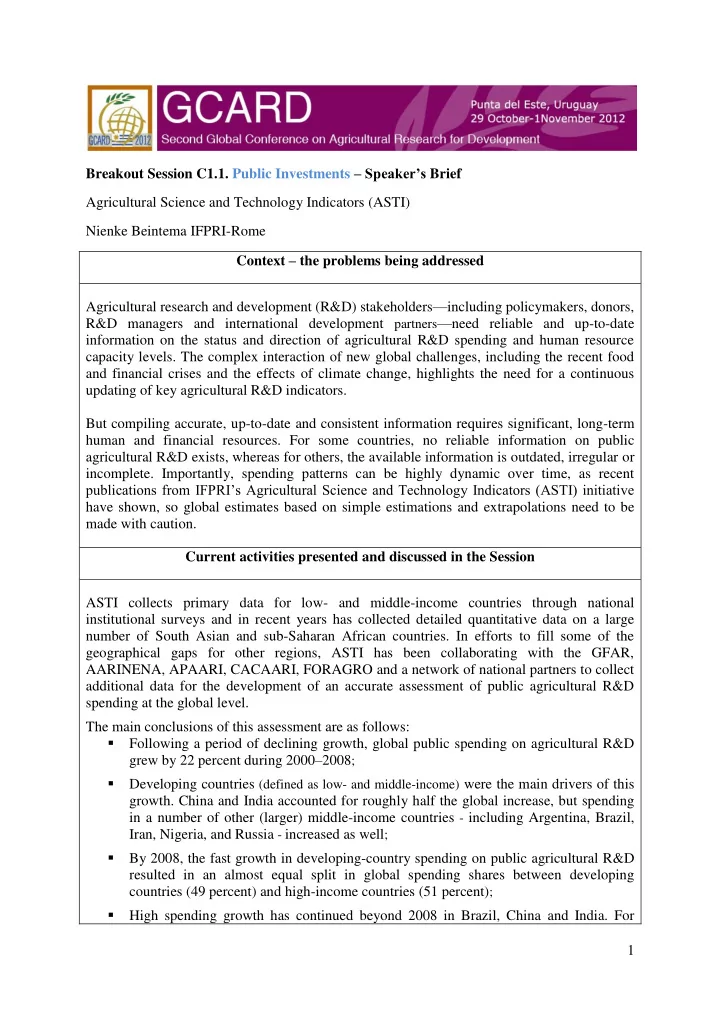

Breakout Session C1.1. Public Investments – Speaker’s Brief Agricultural Science and Technology Indicators (ASTI) Nienke Beintema IFPRI-Rome Context – the problems being addressed Agricultural research and development (R&D) stakeholders — including policymakers, donors, R&D managers and international development partners — need reliable and up-to-date information on the status and direction of agricultural R&D spending and human resource capacity levels. The complex interaction of new global challenges, including the recent food and financial crises and the effects of climate change, highlights the need for a continuous updating of key agricultural R&D indicators. But compiling accurate, up-to-date and consistent information requires significant, long-term human and financial resources. For some countries, no reliable information on public agricultural R&D exists, whereas for others, the available information is outdated, irregular or incomplete. Importantly, spending patterns can be highly dynamic over time, as recent publications from IFPRI’s Agricultural Science and Technology Indicators (ASTI) initiative have shown, so global estimates based on simple estimations and extrapolations need to be made with caution. Current activities presented and discussed in the Session ASTI collects primary data for low- and middle-income countries through national institutional surveys and in recent years has collected detailed quantitative data on a large number of South Asian and s ub-Saharan African countries. In efforts to fill some of the geographical gaps for other regions, ASTI has been collaborating with the GFAR, AARINENA, APAARI, CACAARI, FORAGRO and a network of national partners to collect additional data for the development of an accurate assessment of public agricultural R&D spending at the global level. The main conclusions of this assessment are as follows: Following a period of declining growth, global public spending on agricultural R&D grew by 22 percent during 2000 – 2008 ; Developing countries (defined as low- and middle-income) were the main drivers of this growth. China and India accounted for roughly half the global increase, but spending in a number of other (larger) middle-income countries - including Argentina, Brazil, Iran, Nigeria, and Russia - increased as well ; By 2008, the fast growth in developing-country spending on public agricultural R&D resulted in an almost equal split in global spending shares between developing countries (49 percent) and high-income countries (51 percent) ; High spending growth has continued beyond 2008 in Brazil, China and India. For 1
Brazil and China in particular, long-term government commitment to agricultural R&D and a supportive policy environment have fuelled increased agricultural productivity, as well as overall economic growth - evidence of the benefits of government investment in agricultural R&D ; Despite the growth in public spending on agricultural R&D in several developing countries during 2000 - 2008, spending in many low-income countries either stagnated or declined ; Many low-income countries - particularly in Sub-Saharan Africa - are extremely vulnerable to yearly shocks in agricultural R&D spending because they are highly dependent on donor funding and development bank loans , which by nature are short term and ad hoc ; Private-sector involvement in agricultural R&D has increased over time, although it should be noted that high-income countries dominate and the majority of growth occurred in areas related to agribusiness rather than agricultural production (that is, manufacturing not agriculture). Intended outcomes Changing the widespread perception of agricultural R&D stakeholders that globally growth agricultural R&D investments are no longer declining, but have in fact increased substantially since the turn of the millennium ; However, ma jority of the poorest countries continue to have low, often declining and stagnating investment levels that are highly volatile. More attention should be given to these countries in terms of better-coordinated government and donor support as well as in the debates related to south-south and north-south cooperation . Commitments to collective actions in 2012-2014 (national, regional or international) i. With existing resources Monitoring agricultural R&D investments and human resource capacities at national levels in Africa, South Asia and the Middle East. ii. With additional support Monitoring agricultural R&D investments and human resource capacities at national, regional and global levels for all regions; Provid ing a global assessment of agricultural R&D investment and human resource levels for the year 2012 at GCARD-2014. iii. With specific large scale program investment Monitoring agricultural R&D investments and the results of these investments at national, regional, and global levels. 2
3
Recommend
More recommend